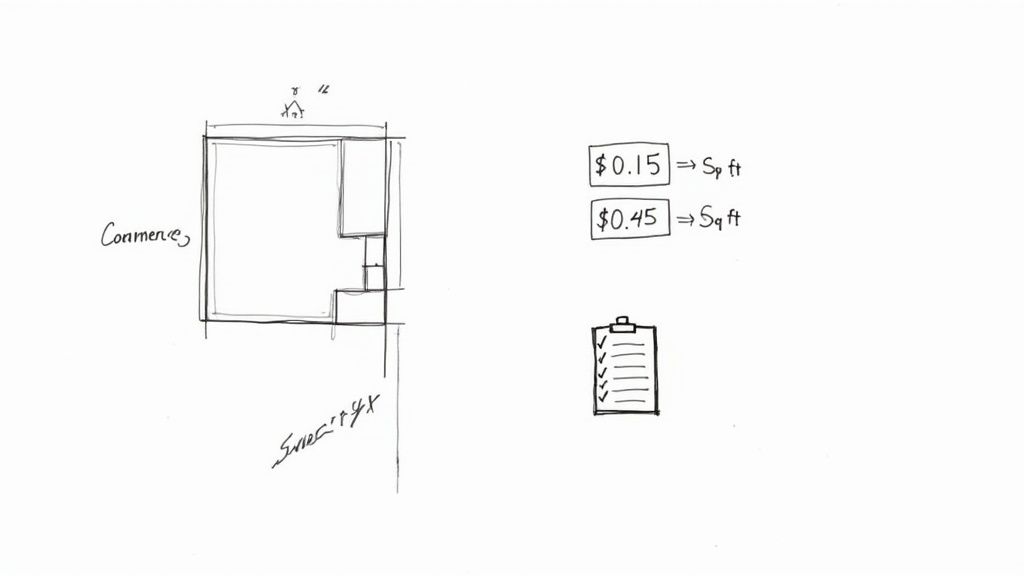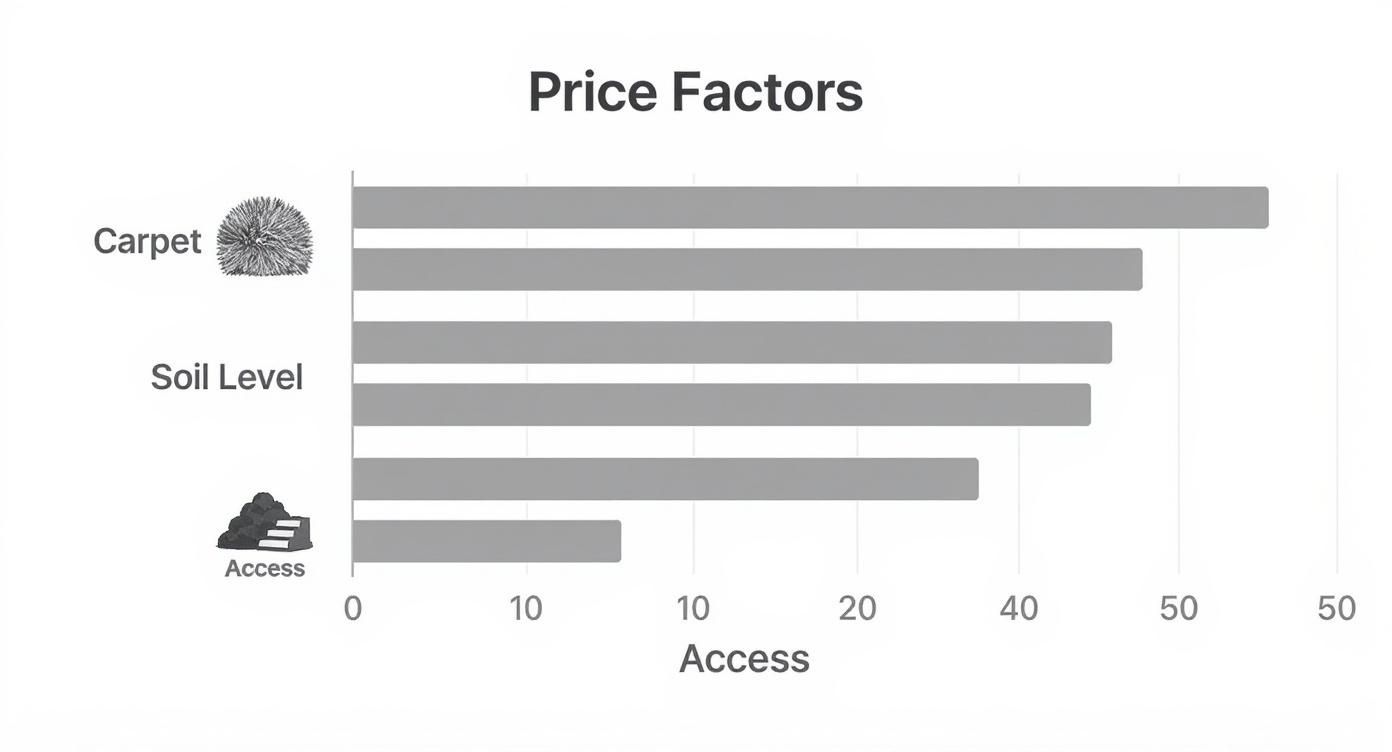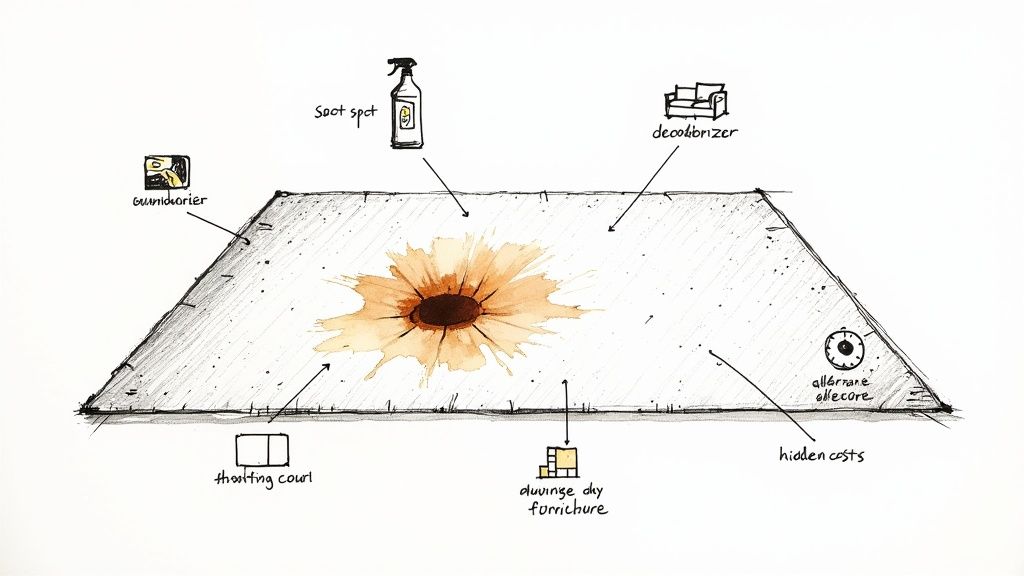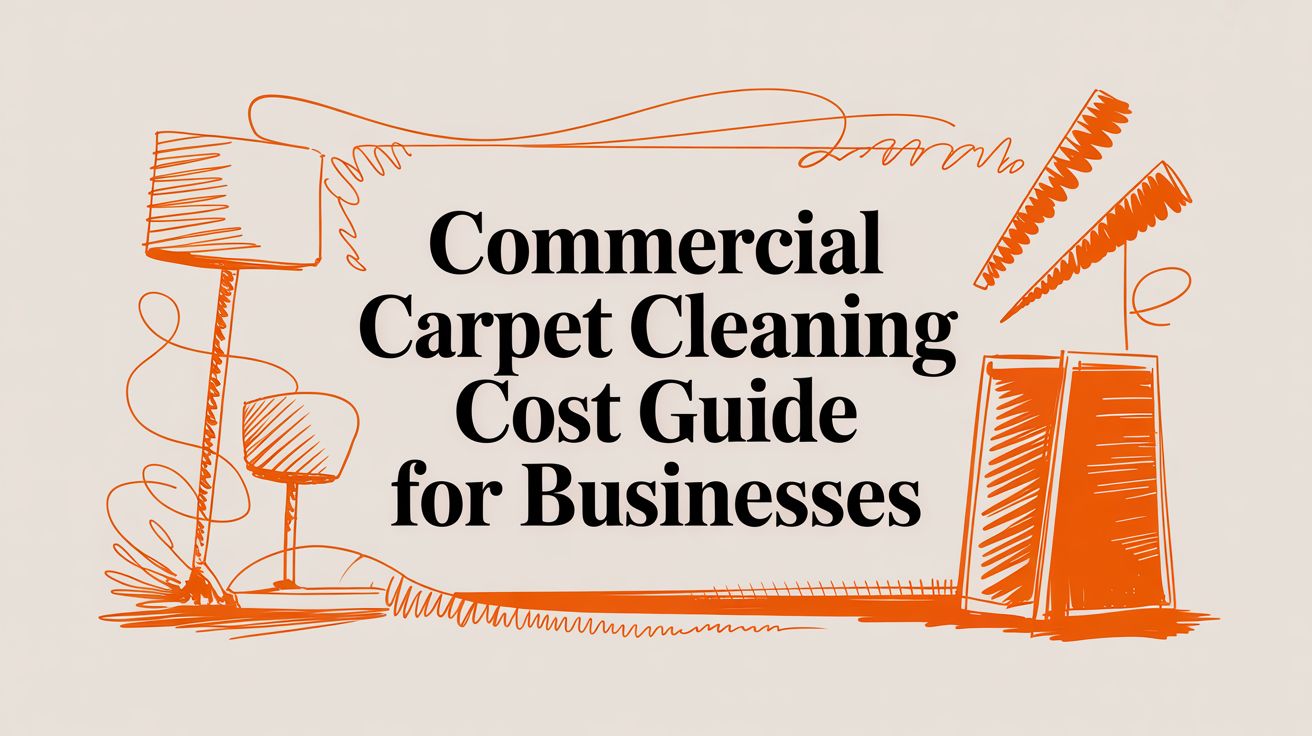So, what's the real cost for commercial carpet cleaning? The honest answer is… it depends. But for budgeting purposes, most businesses should plan on a rate somewhere between $0.15 and $0.45 per square foot.
That range gives you a solid ballpark figure. Your final price will shift up or down based on the cleaning method, how grimy the carpets are, and if you need any specialized treatments.
Decoding Your Carpet Cleaning Quote

Think of a carpet cleaning quote like a mechanic's invoice. The final number isn't just a single item; it's the sum of different parts, from labor to specific services. While the total square footage sets the baseline, a few other key factors will nudge your price toward the lower or higher end of that spectrum.
Let's break down exactly what drives those costs so you can read any quote with total confidence.
Estimated Commercial Carpet Cleaning Rates Per Square Foot
Here’s a quick-glance table to help you see how different cleaning methods and soil levels affect the price. This should give you a clearer picture of what to expect.
| Cleaning Method | Light Soiling (per sq. ft.) | Medium Soiling (per sq. ft.) | Heavy Soiling (per sq. ft.) |
|---|---|---|---|
| Hot Water Extraction (Steam Cleaning) | $0.20 – $0.30 | $0.30 – $0.40 | $0.40 – $0.55+ |
| Encapsulation (Low-Moisture) | $0.15 – $0.25 | $0.25 – $0.35 | $0.35 – $0.45 |
| Dry Compound Cleaning | $0.18 – $0.28 | $0.28 – $0.38 | $0.38 – $0.50 |
As you can see, a lightly soiled area cleaned with a low-moisture method is going to be far more affordable than tackling a heavily stained, high-traffic hallway with deep steam cleaning.
If you're interested in a deeper dive into how businesses break down these kinds of expenses, you might want to explore the principles of micro-estimation for business costs. It’s a great way to get granular with line-item charges and build a much more precise budget.
Key Factors That Drive Your Final Price
Thinking about what commercial carpet cleaning will cost is a lot like pricing out a new car. Sure, every car has a base price, but the final number on the sticker changes fast once you start adding features. The same thing happens here. Your square footage sets the starting point, but a few key details will determine the final quote you get.
Understanding these variables is the key to creating a realistic budget. A quote for a small, quiet office is going to look a whole lot different than one for a busy restaurant with years of caked-on grime. Let's break down the main things that can move the price up or down.
Carpet Type And Condition
First off, not all carpets are created equal, and the material itself really matters. A low-pile, tough Berber carpet—the kind you see in most offices—is usually pretty straightforward and quick to clean. It’s built for heavy use.
On the other hand, if you've got a plush, high-pile carpet, that's a different story. It needs a more delicate touch, special equipment, and it's going to take a lot longer to dry. That extra time and complexity will absolutely show up in the cost. If the carpet is old and frayed, cleaners have to work much more carefully, which can also add to the final price.
Soil Level And Stain Complexity
After the size of the room, the single biggest factor is just how dirty the carpet is. This is where a professional eye makes all the difference, because what looks like a little dirt to you might actually be deep-down grime that's going to take a lot of work to get out.
- Light Soiling: Think general dust and light foot traffic. This is common in private offices or conference rooms that don't get used every single day.
- Medium Soiling: You'll see this in hallways or the main parts of an office. It involves more obvious dirt and the occasional small spill that isn't greasy.
- Heavy Soiling: This is what you find in high-traffic entrances, restaurant dining rooms, or industrial spaces. We're talking ground-in dirt, grease, food stains, and major discoloration.
A heavily soiled carpet might need special pre-treatment sprays, multiple passes with the cleaning machine, and stronger solutions. This can easily increase the time and material costs by 25-50% or more compared to a lightly soiled carpet.
Accessibility And Layout
Finally, the simple layout of your space plays a big role. A huge, wide-open office on the ground floor with no furniture is a dream scenario for a cleaner. But things get more complicated—and more expensive—when we run into challenges like these:
- Multiple floors that mean hauling heavy equipment up and down stairs.
- Rooms packed with heavy desks, cubicles, or filing cabinets that all need to be moved.
- Tight, cramped spaces or a bunch of small rooms that just slow the whole process down.
For more details on how pros figure all this out, our guide to understanding carpet cleaning pricing takes a deeper dive into the quoting process.
Comparing Cleaning Methods and Their Cost Impact
Choosing a cleaning service isn't just about finding someone to run a machine over your floors; you're picking the right tool for the job. The method a company uses has a huge impact on the commercial carpet cleaning cost, how long your space is out of commission, and, of course, the final results. Knowing the difference between them helps you make a smart call for both your budget and your daily operations.
Think of it like washing your car. A quick drive-through rinse is cheap and fast, but it won't touch that caked-on mud. A full, hand-wax detail costs more and takes longer, but the car looks brand new. Carpet cleaning is pretty similar—you're balancing cost, time, and deep-cleaning power.
Hot Water Extraction (Steam Cleaning)
This is the one most people know as "steam cleaning," and it's the undisputed heavyweight champion of deep cleaning. It works by shooting a high-pressure mix of hot water and cleaning agents deep into the carpet fibers, breaking up all the embedded dirt, grime, and allergens. Then, a beast of a vacuum sucks it all back out.
- Best For: Restaurants, healthcare facilities, or any place that needs a serious, restorative, and sanitizing clean.
- Cost Impact: This is usually the priciest option. The heavy-duty equipment, intensive labor, and longer time on-site all add up.
- Downside: The biggest headache is the drying time. We're talking anywhere from 6 to 24 hours, which is a dealbreaker for businesses that can't afford that much downtime.
Low-Moisture and Dry Cleaning Methods
For businesses where every minute of downtime costs money, low-moisture methods are a lifesaver. These techniques are all about maintenance and quick turnarounds, making them perfect for busy offices, hotels, and retail stores.
Encapsulation Cleaning is a slick, modern low-moisture technique. It uses a special polymer-based detergent that crystallizes around dirt particles, literally "encapsulating" them. Once it's dry, a quick vacuuming whisks the crystals—and the trapped dirt—away, leaving zero sticky residue behind.
This method is fantastic for high-traffic spots like office hallways and lobbies. Because it uses so little water, carpets are typically dry and ready for people to walk on in just 1-2 hours. That means minimal disruption to your business day.
Dry Compound Cleaning is the speed demon of carpet cleaning. It uses a powder-like compound that gets worked into the carpet. This compound acts like a tiny sponge, absorbing all the soil, and is then vacuumed up. It has zero drying time, making it the absolute fastest option. The trade-off? It's really best for surface-level cleaning and might not knock out deep, set-in stains like other methods can.
If you want to dive deeper, you can learn more about the differences between low-moisture VLM versus traditional steam cleaning.
The infographic below gives you a good visual on how things like carpet type and soil level point you toward one cleaning method over another, which in turn affects your final price.

As you can see, there’s no magic bullet. The right choice always comes down to your specific building, your traffic, and what you need to accomplish.
The Hidden Costs of Specialized Treatments
Think of your cleaning quote like a basic car wash. It's going to handle the everyday dust and dirt, no problem. But what about the really tough stuff? Your business's carpets face a daily battle with stubborn stains, weird smells, and high-traffic areas that get ground down. A standard clean just won't cut it for those.
These specialized services are what truly keep your carpets looking professional, but they will bump up your total commercial carpet cleaning cost. It's the difference between that basic wash and a full detail—the detail costs more because it’s targeting specific problems, and it’s the same with your carpets.

Common Add-On Services and Their Costs
Beyond that initial square-foot rate, you'll almost certainly see a few extra charges for services that go above and beyond a general cleaning. Don't think of these as unnecessary upsells; they're essential for tackling specific issues and protecting your carpet investment for the long haul.
Here are a few common treatments you might see on your final invoice:
- Spot and Stain Removal: This is for those nightmare stains—ink, coffee, wine, you name it. It requires special chemical treatments and a lot more elbow grease. This can easily add $25 to $100 or more to your bill, depending on how big and bad the stain is.
- Deodorizing and Odor Removal: Got a funky smell from spilled food, moisture, or maybe a visiting pet? A simple cleaning just masks it. Professional deodorizing treatments actually neutralize the odor at its source, often using powerful enzymatic cleaners. If you're curious about the science, you can learn more about what an enzymatic cleaner is and see how they break down the organic gunk causing the smell.
- Carpet Protectant Application: Think of services like Scotchgard as an invisible shield for your carpet. It creates a barrier that repels liquids and dirt, which makes future cleanups a breeze and helps the carpet last longer. Expect to pay an extra $0.10 to $0.20 per square foot for this—it's well worth it.
And be prepared for a few other things that can affect your budget. If the crew has to move heavy office furniture, come in after hours or on a weekend, or deal with carpets that are just exceptionally filthy, you can bet there will be extra fees. It all comes down to the extra labor and time involved.
How Industry Trends Are Shaping Your Cleaning Bill
When you get a quote for commercial carpet cleaning, you're seeing more than just the cost of a crew and their supplies. The price is also a reflection of bigger shifts happening across the entire industry. Just like the car world is going electric, the cleaning world is going green.
Two of the biggest forces at play right now are sustainability and technology. They're completely changing how pros clean carpets, and that has a direct impact on your wallet.
There's a huge and growing demand for eco-friendly, non-toxic cleaning agents that are safer for your employees, customers, and the planet. Think of them as the "organic" option for your floors.
These "green" products can sometimes carry a slightly higher price tag upfront. But the payoff is massive: better indoor air quality, a smaller environmental footprint, and peace of mind knowing you're not filling your space with harsh chemicals.
The Impact of New Technology
At the same time, cleaning equipment is getting a major upgrade. We're seeing amazing advancements like low-moisture machines and even robotic cleaners that can get better results in way less time. This kind of efficiency can absolutely influence a company's pricing model.
It's all part of a much larger market shift. In fact, the global carpet cleaner market is expected to rocket to $1,321.03 million by 2033. What's driving that? You guessed it: the widespread adoption of these new technologies and greener detergents.
While the cleaning companies investing in this high-tech gear have higher initial costs, the long-term efficiency often allows them to offer very competitive prices to clients like you. For a deeper dive into the numbers, you can check out more data on carpet cleaning market growth at Straits Research.
A Few Final Questions About Carpet Cleaning Costs
Even with a budget hammered out, you probably have a few more questions rattling around. It's only natural. Getting straight answers helps you make smarter calls for your building and avoid getting ripped off.
Let's dig into some of the most common things business owners ask us.
How Often Should We Really Be Cleaning Our Office Carpets?
The simple answer comes down to one word: traffic.
A busy lobby or a main hallway that sees constant foot traffic might need a professional cleaning every 3-4 months. But a private, low-traffic office? You could easily go 6-12 months between cleanings.
The real goal isn't just cleaning—it's maintenance. You want a schedule that stops dirt from getting ground so deep it permanently damages the carpet fibers. Staying ahead of the game is way cheaper than waiting until the carpet looks awful and then paying for a massive restoration job.
Is It Actually Cheaper to Sign a Maintenance Contract?
For almost every business, the answer is a big yes. Cleaning companies will almost always give you a better deal for scheduled, regular service than for a one-time emergency call. Think of it like a subscription versus buying one-off.
A contract gives you two huge wins. First, you get predictable expenses, which makes budgeting a breeze. Second, that regular care protects your carpet, making it last longer and saving you from those pricey deep cleans down the road. It’s an investment that absolutely pays for itself.
A transparent quote is an itemized one. It should clearly list the total square footage, the cost per square foot, the specific cleaning method being used, and a line-by-line breakdown of any add-on services like stain removal or protective treatments. It should also explicitly state whether services like moving furniture are included.
What Should a Good Cleaning Quote Always Include?
A trustworthy quote leaves no room for guessing. If you just get a single, vague number, that's a huge red flag. You want to see a full breakdown that includes:
- The exact square footage being cleaned.
- The price per square foot.
- The cleaning method they plan to use (like Hot Water Extraction).
- An itemized list of any extra charges for things like spot treatments, deodorizers, or moving furniture.
This kind of detail means you know exactly what you’re paying for. It protects you from those nasty surprise fees on the final bill and shows you're dealing with a pro.
Ready for a quote that’s clear, fair, and free of the usual games? At Citrus Carpet Cleaning Buford, we give you upfront "EXACT-imates" so you know the final price before we even show up. Give us a call or text to get yours today at https://citruscarpetcleaningatlanta.com.

